Is it possible to exercise while fasting? This is a common question we hear all the time. People think that food gives them energy and therefore it will be difficult to fast and exercise at the same time. Some people with physically demanding jobs feel that they could not fast and work properly. What’s the truth?
Well, let’s think about this logically for a second. When you eat, insulin goes up telling your body to use some of that food energy immediately. The remainder is stored as sugar (glycogen in the liver). Once the glycogen stores are full, then the liver manufactures fat (DeNovo Lipogenesis). Dietary protein is broken down into component amino acids. Some is used to repair proteins but excess amino acids are turned to glucose. Dietary fat is absorbed directly by the intestines. It doesn’t undergo any further transformation and is stored as fat.
Insulin’s main action is to inhibit lipolysis. This means that it blocks fat burning. The incoming flood of glucose from food is sent to the rest of the body to be used as energy.Macro oxidation
So what happens during a fast? Well, it’s just the process in reverse. First, your body burns the stored sugar, then it burns the stored fat. In essence, during feeding you burn food energy. During fasting, you burn energy from your stored food (sugar and fat).
Note that the amount of energy that is used by and available to your body stays the same. The basal metabolic rate stays the same. This is the basic energy used for vital organs, breathing, heart function etc. Eating does not increase basal metabolism except for the small amount used to digest food itself (the thermic effect of food).
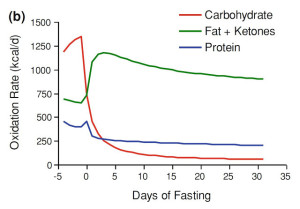
If you exercise while fasting, the body will start by burning sugar. Glycogen is a molecule composed of many sugars all put together. When it comes time to use it for energy, the liver simply starts breaking all the chains to release the individual sugar molecules that can now be used for energy.
As mentioned before, short term storage of food energy (glycogen) is like a refrigerator. The food energy goes in and out easily, but there is limited storage. Long term storage (fat) is like a freezer. Food is harder to get to, but you can store much more of it. If you eat 3 times a day, it’s like you go shopping for food 3 times a day and any leftovers get stored in the fridge. If there is too much for the fridge, it goes into the freezer.
So what happens during fasting and exercise? Well, the body simply pulls energy out of the ‘fridge’. Since you have enough glycogen stored up to last over 24 hours on a regular day, you would need to do some serious exercise for a long time before you could exhaust those stores.

Endurance athletes occasionally do hit this ‘wall‘, where glycogen stores run out. Perhaps there is no more indelible image of hitting the wall as the 1982 Ironman Triathlon where American competitor Julie Moss crawled to the finish line, unable to even stand. Athletes also term complete exhaustion of short term energy stores ‘bonking’. I know some of you may think ‘bonking’ refers to other activities done on all fours, but this is a nutritional blog!
So, how do you get around that? Glycogen stores are not enough to power you through the entire IronMan race. However, you know at the same time, that you are still carrying vast amounts of energy in the form of fat. All that energy is stored away and not accessible during exercise. But the only reason it cannot be used is because your body is not adapted to burn fat.
By following a very low carbohydrate diet, or ketogenic diet, you can train your body to burn fat. Similarly, by exercising in the fasted state, you can train your muscles to burn energy. Now, instead of relying on limited by easily accessible glycogen during competition, you are carrying around almost unlimited energy drawn directly from your fat stores.
Studies are starting to demonstrate the benefits of such training. For example, this study looked at muscle fibres both before and after training in the fasted state. This means that you fast for a certain period of time, usually around 24 hours and then do your endurance or other training. The combination of low insulin and high adrenalin levels created by the fasted state stimulates adipose tissue lipolysis (breakdown of fat) and peripheral fat oxidation (burning of fat for energy). Other studies had already shown that breakdown of intramyocellular lipids (IMCL – fat inside the muscle) is increased by training in the fasted state.Six weeks of training in the fasted state also induced a greater increase of fatty acid binding protein and uncoupling-protein-3 content in muscle.
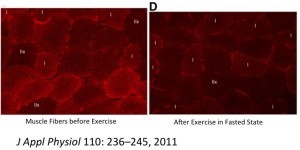
What does this mean in plain English? It means that our bodies have the wonderful ability to adapt to what’s available. When we fast, we deplete much of the stored sugar (glycogen). Our muscles then become much more efficient at using fat for energy. This happens because muscle ‘learns’ how to use the fat as energy by increasing the amount of proteins that metabolize that fat. In other words, our muscles learn to burn fat, not sugar.
Looking at muscle cells before and after exercise in the fasted state, you can see that there are more muscle bundles, but also that there is a deeper shade of red, indicating more available fat for energy.
Legendary exercise physiologist and physician Tim Noakes of Cape Town, South Africa has led the way in understanding the benefits of low carbohydrate diets for elite level athletes. Many national level teams (such as the Australian cricket team) are now applying these lessons to crush their competition. Legendary NBA players such as LeBron James, Kobe Bryant and Carmelo Anthony are turning to low carbohydrate, high fat diets to slim down and prolong their careers.

You can be damn certain that these elite level athletes would not be doing this Low Carb mumbo jumbo and training in the fasted state malarky if it had any detrimental effect on their athletic performance. Quite the contrary. Hall of Fame NBA player Steve Nash does not eat simple carbs at any cost. Drinking sugary Gatorade? Not bloody likely to help.
Another study looked at the effects of a 3.5 day fast on all different measures of athletic performance. They measured strength, anaerobic capacity and aerobic endurance. All of these measures did not decrease during the fasting period.
The body simply switches from burning sugar to burning fat. But, for endurance athletes, the increase in available energy is a significant advantage, since you can store infinitely more energy in the form of fat rather than sugar. If you are running ultra marathons, being able to utilize your almost unlimited fat energy instead of highly limited glycogen energy will mean that you won’t ‘bonk’ and might just win you that race.
During the period where you are adjusting to this change, you will likely notice a decrease in performance. This lasts approximately 2 weeks. As you deplete the body of sugar, your muscles need time to adapt to using fat for energy. Your energy, your muscle strength and overall capacity will go down, but they will recover. So, LCHF diets, ketogenic diets and training in the fasted state may all have benefits in training your muscles to burn fat, but they do require some time to adapt.

Consider an analogy. Imagine that our bodies are fuel tankers. We drive these large tankers around, but only have a limited amount of gas in the gas tank. After the gas tank runs out, we are stuck on the side of the road calling for help. But wait, you might say. That’s ironic. You are carrying an entire tank of gas, but ran out of gas. How is that so? Well, that gas is not accessible.
In the same manner, we carry around huge stores of energy as fat. But our muscles are trained to run on sugar, and run out of energy, so we need to continually refuel despite the large tank of fuel stored as fat.
So, what my best advice on physical exertion and fasting? Don’t worry about it. Do everything you normally do during fasting. If you normally exercise, or even if you don’t, you can still do it during fasting. Whether you fast for 24 hours or 24 days, you an still exercise. Your muscles may take up to 2 weeks to become fat adapted, though. During the first 2 weeks of fasting, you may need to take it a little easy, but you should quickly recover after that.
Jason Fung, MD.







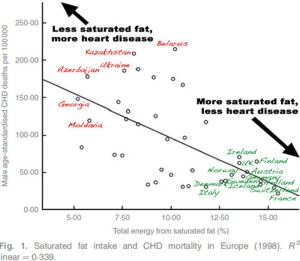
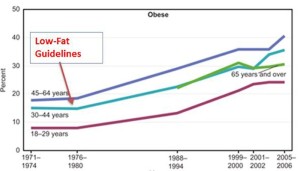
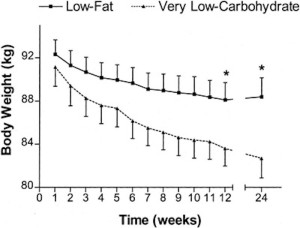

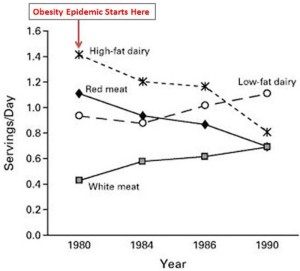
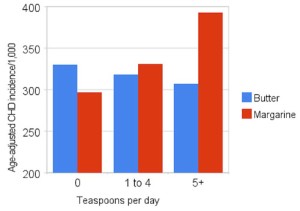
 Weight problems cannot be measured by numbers, according to David Ludwig.
Weight problems cannot be measured by numbers, according to David Ludwig.